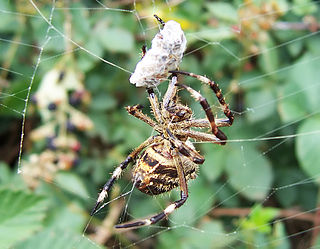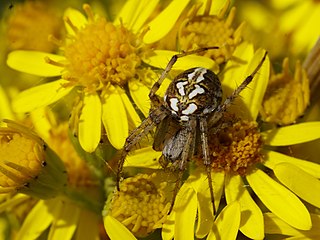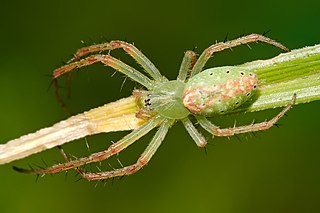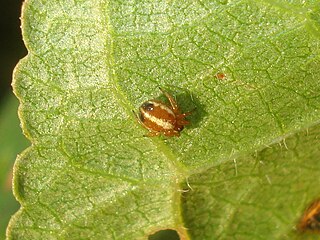
Orb-weaver spiders are members of the spider family Araneidae. They are the most common group of builders of spiral wheel-shaped webs often found in gardens, fields, and forests. The English word "orb" can mean "circular", hence the English name of the group. Araneids have eight similar eyes, hairy or spiny legs, and no stridulating organs.

The Australian garden orb weaver spider is a very common species of spider with many variants in size, shape, and colour across the coastal and northern regions of Australia. They have very large abdomens when well-fed and exhibit a tremendous colour-range from off-white through tan, brown to almost black. They have a roughly leaf-shaped pattern on the top of their abdomen with a complex outline that is darker than the surrounding area. There may also be several whitish spots or one or more stripes. The spiders' cephalothoraxes (heads) and proximal leg segments are usually darker, mostly reddish or reddish brown. They are able to change their colour with each moult to better match the background upon which they rest during the day.

Eriophora is a genus of orb-weaver spiders first described by Eugène Simon in 1895. It occurs in the Americas and Africa. The name is derived from Ancient Greek roots, and means "wool bearing".

Gasteracantha is a genus of orb-weaver spiders first named by Carl Jakob Sundevall in 1833. Species of the genus are known as spiny-backed orb-weavers, spiny orb-weavers, or spiny spiders. The females of most species are brightly colored with six prominent spines on their broad, hardened, shell-like abdomens. The name Gasteracantha is derived from the Greek gaster (γαστήρ), meaning "belly, abdomen", and akantha (άκανθα), meaning "thorn, spine". Spiny-backed orb-weavers are sometimes colloquially called "crab spiders" because of their shape, but they are not closely related to the true crab spiders. Other colloquial names for certain species include thorn spider, star spider, kite spider, or jewel spider.

Psechridae is a family of araneomorph spiders with about 70 species in two genera. These are among the biggest cribellate spiders with body lengths up to 2 centimetres (0.79 in) and funnel webs more than 1 metre in diameter.

Zygiella is a genus of orb-weaver spiders first described by F. O. Pickard-Cambridge in 1902. In 2015, Parazygiella was determined to be a taxonomic synonym of Zygiella, and its species were moved to Zygiella.

Leucauge is a spider genus of long-jawed orb weavers, with over 160 species and fully pantropical distribution.

Neoscona, known as spotted orb-weavers and barn spiders, is a genus of orb-weaver spiders (Araneidae) first described by Eugène Simon in 1895 to separate these from other araneids in the now obsolete genus Epeira. The name Neoscona was derived from the Greek νέω, meaning "spin", and σχοῖνος, meaning "reed" They have a mostly pantropical distribution and one species, Neoscona adianta, has a palearctic distribution. As of April 2019 there are eight species that can be found in the United States and Canada:

Cyrtophora, the tent-web spiders, is a genus of orb-weaver spiders first described by Eugène Simon in 1895. Although they are in the "orb weaver" family, they do not build orb webs. Their tent-like, highly complex non-sticky web is sometimes considered a precursor of the simplified orb web. These webs are aligned horizontally, with a network of supporting threads above them. These spiders often live in colonies. Females have a body length of mostly about 10 millimetres (0.39 in) long. Some members, including Cyrtophora cicatrosa, exhibit the ability to change colour rapidly.
Chorizopes is a genus of orb-weaver spiders first described by O. Pickard-Cambridge in 1871. Though it belongs to the orb weaver family, these spiders move through leaf litter preying on other spiders rather than spinning webs. The original name was "Chorizoopes", but the emendationChorizopes by Tamerlan Thorell is now protected by usage.

Phonognatha is a genus of South Pacific orb-weaver spiders first described by Eugène Simon in 1895. It was originally placed with the long-jawed orb weavers, and was moved to Araneidae in 2008.

Larinia is a genus of orb-weaver spiders first described by Eugène Simon in 1874.

Plebs is a genus of orb-weaver spiders first described by M. M. Joseph & V. W. Framenau in 2012. Though many of its species have been moved around, a 2012 taxonomic revision suggested that these spiders comprise a monophyletic genus of closely related spiders that evolved in Australia and, through subsequent movements, spread into parts of Asia and Pacific islands.
Lineacoelotes is a genus of East Asian funnel weavers first described by X. Xu, S. Q. Li & X. P. Wang in 2008.

Eriovixia is a genus of orb-weaver spiders first described by Allan Frost Archer in 1951.
Porcataraneus is a genus of Asian orb-weaver spiders first described by X. Q. Mi & X. J. Peng in 2011. As of April 2019 it contains only three species from India and China.

Wanda Wesołowska is a Polish zoologist known for her work with jumping spiders. She has described more species of jumping spider than any contemporary writer, and is second only to Eugène Simon in the history of arachnology. Originally a student of ornithology, she developed an interest in jumping spiders while still a student at the Siedlce University of Natural Sciences and Humanities in the 1970s.

Singa, also called striped orb-weavers, is a genus of orb-weaver spiders first described by C. L. Koch in 1836. They are small for orb-weavers, reaching 6 millimetres (0.24 in) or less in body length, excluding the legs.
Troglocoelotes is a genus of east Asian funnel weavers. It was first described by B. Li, Z. Zhao and C. T. Zhang in 2019, and it has only been found in China.
Hengconarius is a genus of funnel weavers first described by Zhao & S. Q. Li in 2018.














